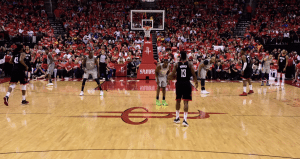
In a past article, “Space and Pace: A Modern Perspective”, we promised some further thoughts on the simple notions of time and space in basketball. Before we do, I’d like to remind readers who are old enough to remember and enlighten those who aren’t that there have been some very successful forbearers to today’s Space and Pace trend.
- Villanova led the nation in scoring this past season averaging 86.6 points per game. That seems like a very nice number but consider that Paul Westhead’s Loyola Marymount teams led the nation in scoring three straight years, averaging 110.3 in 1988, 112.5 in 1989 and 122.4 in 1990. On March 18, 1990, the Lions beat Michigan 149-115 in a 2nd Round NCAA tournament game. Michigan wasn’t too shabby that year as they had won the NCAA title the year before and still had Terry Mills, Rumeal Robinson, Loy Vaught and Sean Higgins. Here’s the whole game on YouTube in case you have an hour and a half to kill.
- The Mike D’Antoni and Steve Nash led Phoenix Suns of the mid-2000’s actually created today’s NBA Space and Pace template with their :07 Seconds or Less offense. Reading Jack McCallum’s book of the same name will recreate that era.
- Not so coincidentally, the cover story, LOST IN SPACE, of the recent May 7th Sports Illustrated is about none other than Mike D’Antoni’s current team, the Houston Rockets. If you open to the story, it features a wide angle two-page photo of James Harden in isolation shooting a jumper over a Jazz defender. There is only ONE other player in the photo-another Jazz defender in a far way help position. There are NO other Rockets in the photo. You have to see it for yourself; talk about spacing! The teaser for the story reads, “Where is everyone? James Harden’s Houston teammates are doing what they do best: getting out of the way and creating room, the guiding tenet of the NBA’s most explosive offense, where threes are demanded, layups welcomed and mid-range runners will get you an “X” on your face.”
- For those who want to play at a fast pace at the defensive end, we have Coach Bob Huggins West Virginia teams to emulate. However, the real forbearer to the Mountaineers’ system would be Coach Kevin Mackey’s mid 1980’s Cleveland State teams. The so-called “run and stun” defense was the cornerstone of Coach Mackey’s program which culminated in an upset of the Indiana Hoosiers and a berth in the 1986 Sweet Sixteen. The pressure system was founded upon making the opponents uncomfortable all possession long for every single possession. Nolan Richardson’s University of Arkansas teams played a similar style in the 90’s that was called “40 Minutes of Hell”.
All along in these discussions, we’ve held that two basic premises are true:
- That acquiring and defending space is a primary goal of the game
- That space equals time. We’ve spent considerable time to date discussing transition and offensive spacing but in the next month or so we’ll also consider a number of other ways to look at basketball space and time. Discussions will include physical prowess such as speed, quickness, height, length, mass, girth, strength and others; skills such as running, sliding, driving, passing, faking, changing pace and direction and others; and intangibles such as resolution, hustle, preparation, anticipation, spontaneity and others.


